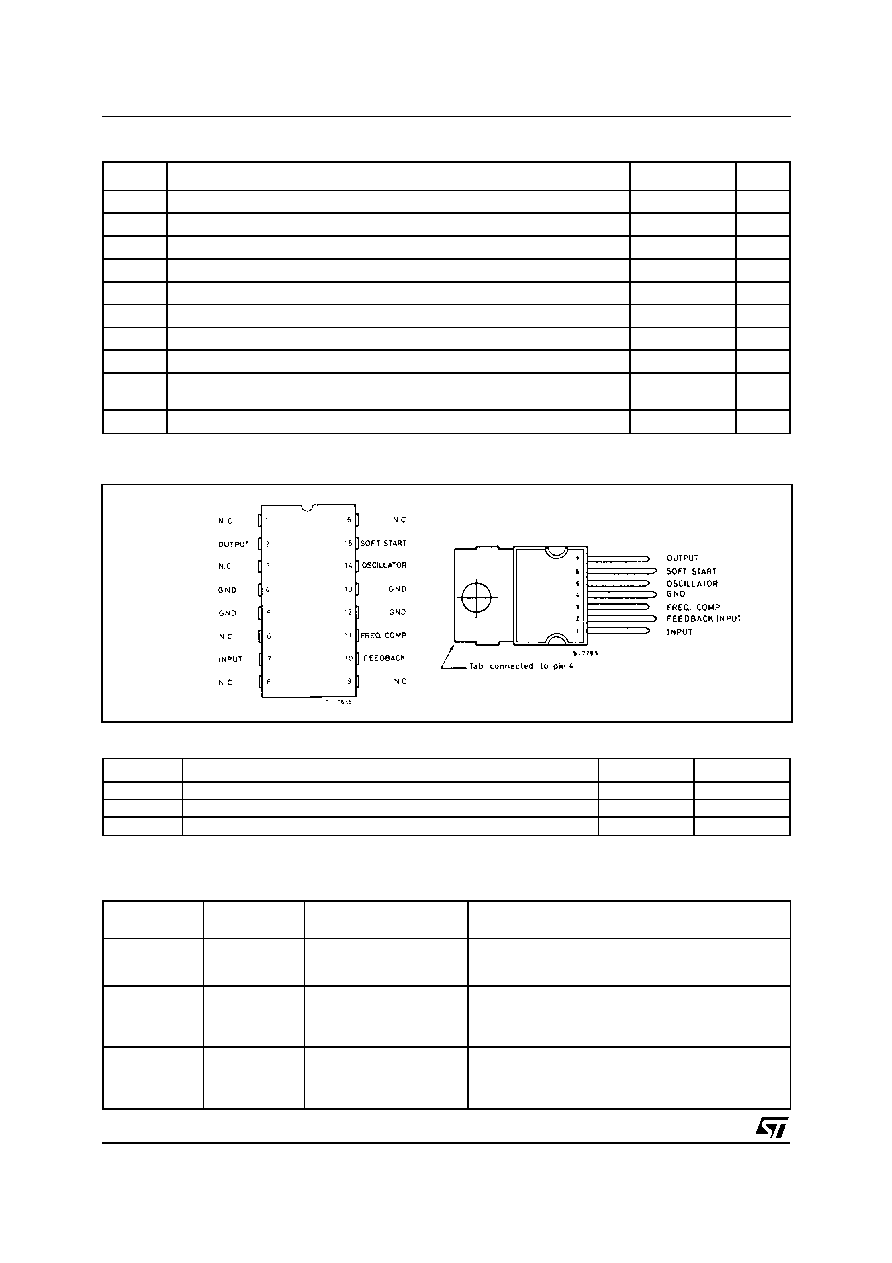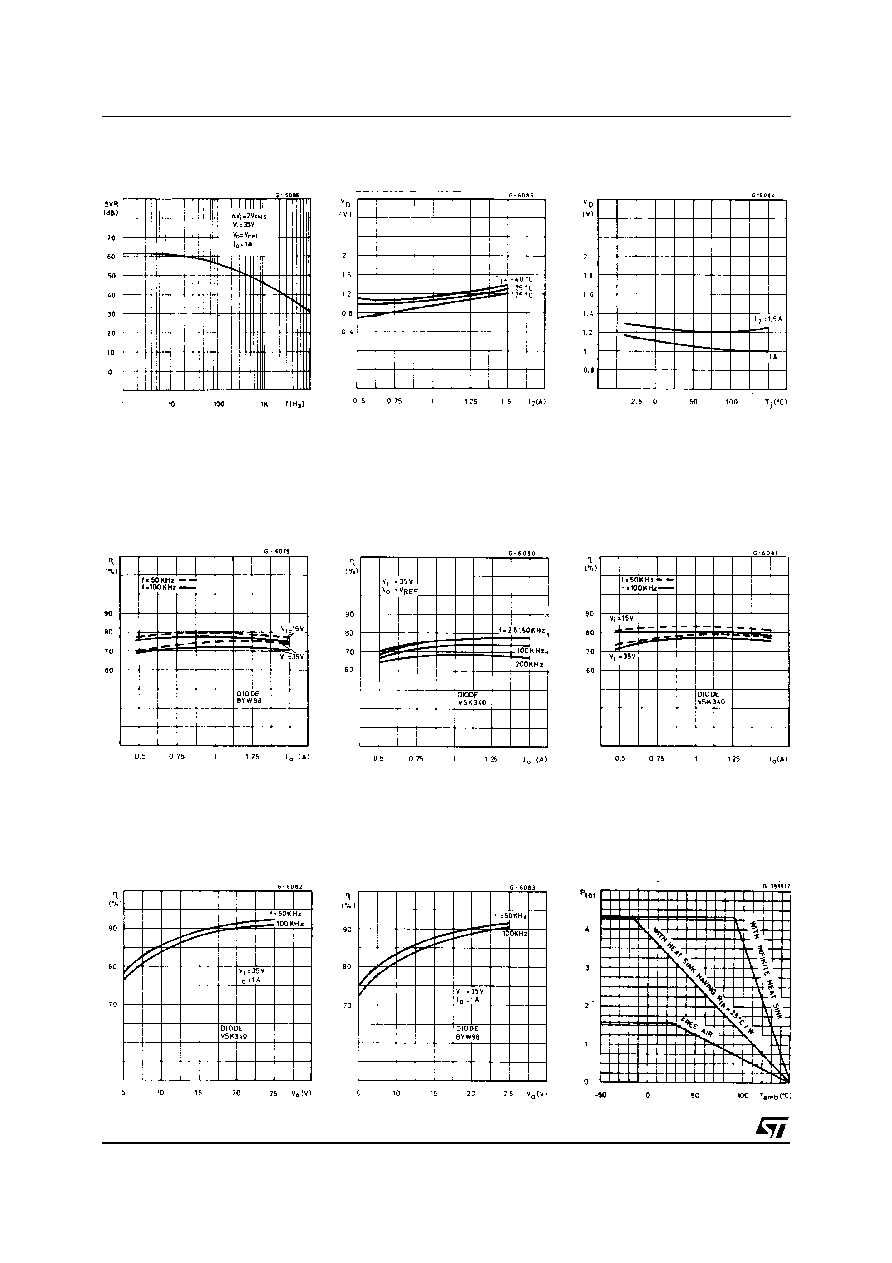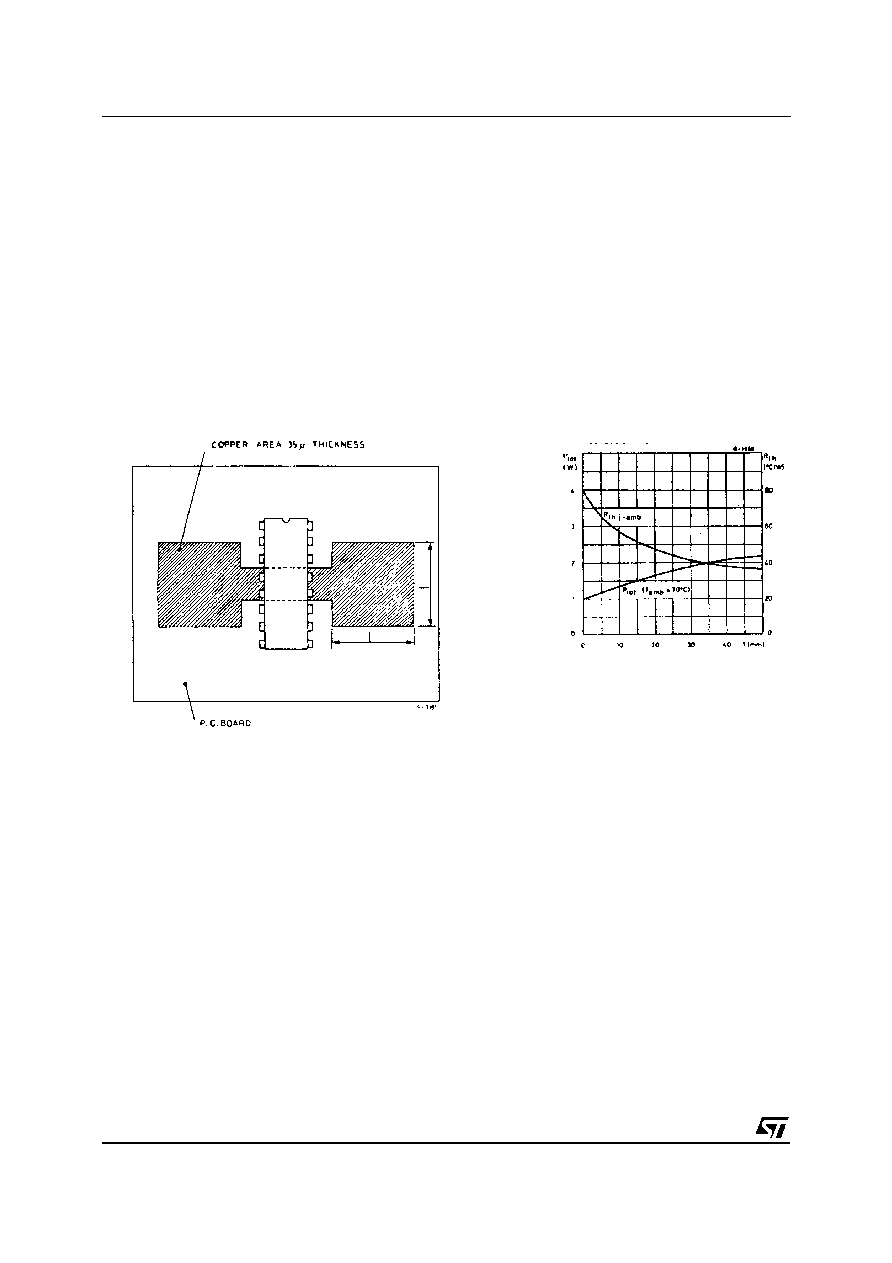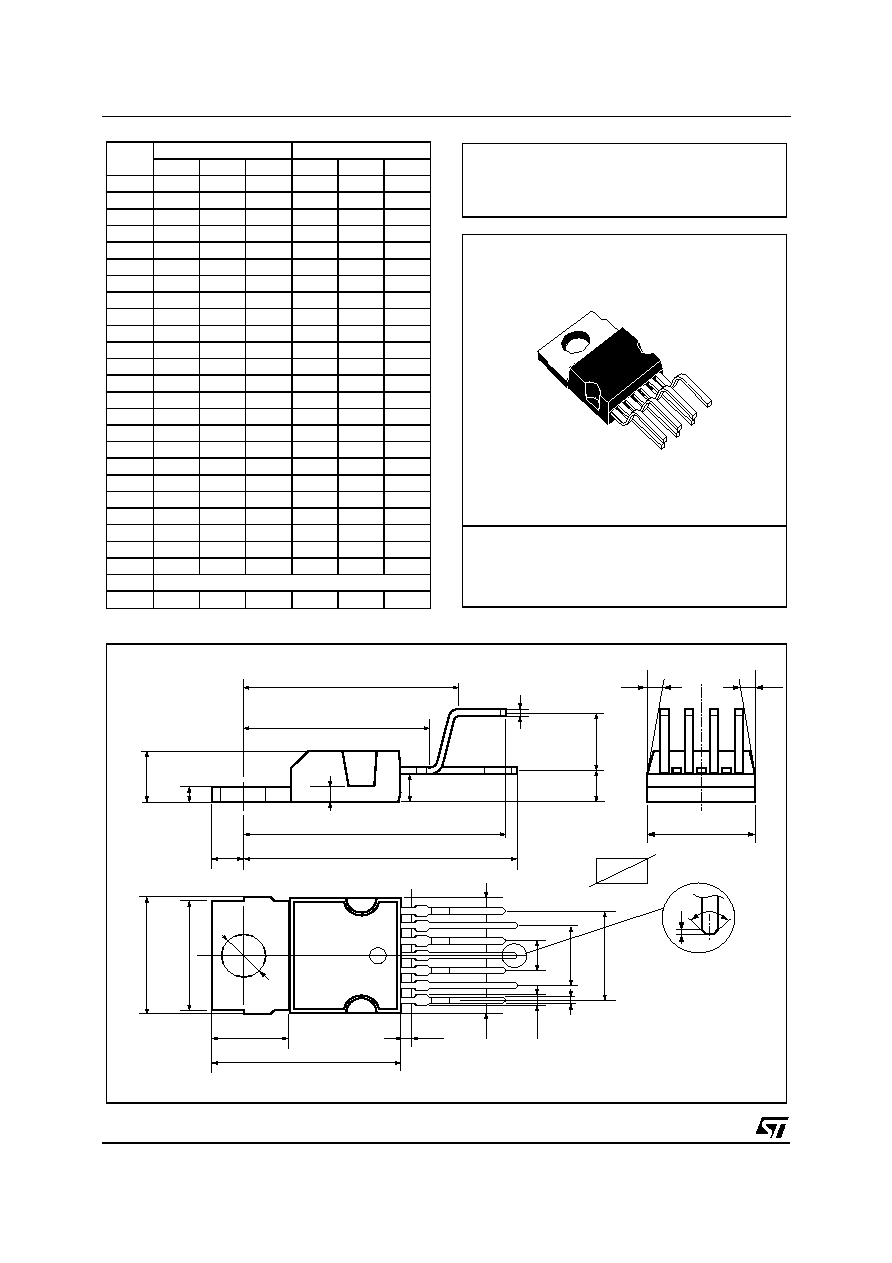 | –≠–ª–µ–∫—Ç—Ä–æ–Ω–Ω—ã–π –∫–æ–º–ø–æ–Ω–µ–Ω—Ç: L4962EH/A | –°–∫–∞—á–∞—Ç—å:  PDF PDF  ZIP ZIP |

Æ
L4962
1.5A POWER SWITCHING REGULATOR
1.5A OUTPUT CURRENT
5.1V TO 40V OUTPUT VOLTAGE RANGE
PRECISE (
±
2%) ON-CHIP REFERENCE
HIGH SWITCHING FREQUENCY
VERY HIGH EFFICIENCY (UP TO 90%)
VERY FEW EXTERNAL COMPONENTS
SOFT START
INTERNAL LIMITING CURRENT
THERMAL SHUTDOWN
DESCRIPTION
The L4962 is a monolithic power switching regula-
tor delivering 1.5A at a voltage variable from 5V to
40V in step down configuration.
Features of the device include current limiting, soft
start, thermal protection and 0 to 100% duty cycle
for continuous operating mode.
June 2000
ORDERING NUMBERS : L4962/A (12 + 2 + 2 Powerdip)
L4962E/A (Heptawatt
Vertical)
L4962EH/A (Horizontal
Heptawatt)
The L4962 is mounted in a 16-lead Powerdip plastic
package and Heptawatt package and requires very
few external components.
Efficient operation at switching frequencies up to
150KHz allows a reduction in the size and cost of
external filter components.
HEPTAWATT
POWERDIP
(12 + 2 + 2)
BLOCK DIAGRAM
Pin X = Powerdip
Pin (X) = Heptawatt
1/16

PIN CONNECTION (Top view)
2/16
Symbol
Parameter
Heptawatt
Powerdip
R
th j-case
Thermal resistance junction-case
max
4
∞
C/W
-
R
th j-pins
Thermal resistance junction-pins
max
-
14
∞
C/W
R
th j-amb
Thermal resistance junction-ambient
max
50
∞
C/W
80
∞
C/W*
* Obtained with the GND pins soldered to printed circuit with minimized copper area.
THERMAL DATA
HEPTAWATT
POWERDIP
NAME
FUNCTION
1
7
SUPPLY VOLTAGE
Unregulated voltage input. An internal regulator powers
the internal logic.
2
10
FEEDBACK INPUT
The feedback terminal of the regulation loop. The output
is connected directly to this terminal for 5.1V operation;
it is connected via a divider for higher voltages.
3
11
FREQUENCY
COMPENSATION
A series RC network connected between this terminal
and ground determines the regulation loop gain
characteristics.
PIN FUNCTIONS
Symbol
Parameter
Value
Unit
V
7
Input voltage
50
V
V
7
- V
2
Input to output voltage difference
50
V
V
2
Negative output DC voltage
-1
V
Output peak voltage at t = 0.1
µ
s; f = 100KHz
-5
V
V
11
, V
15
Voltage at pin 11, 15
5.5
V
V
10
Voltage at pin 10
7
V
I
11
Pin 11 sink current
1
mA
I
14
Pin 14 source current
20
mA
P
tot
Power dissipation at T
pins
90
∞
C (Powerdip)
T
case
90
∞
C (Heptawatt)
4.3
15
W
W
T
j
, T
stg
Junction and storage temperature
-40 to 150
∞
C
ABSOLUTE MAXIMUM RATINGS
L4962

Symbol
Parameter
Test Conditions
Min.
Typ.
Max.
Unit
DYNAMIC CHARACTERISTICS
V
o
Output voltage range
V
i
= 46V
I
o
= 1A
V
ref
40
V
V
i
Input voltage range
V
o
= V
ref
to 36V
I
o
= 1.5A
9
46
V
V
o
Line regulation
V
i
= 10V to 40V V
o
= V
ref
I
o
= 1A
15
50
mV
V
o
Load regulation
V
o
= V
ref
I
o
= 0.5A to 1.5A
8
20
mV
V
ref
Internal reference voltage
(pin 10)
V
i
= 9V to 46V
I
o
= 1A
5
5.1
5.2
V
V
ref
T
Average temperature
coefficient of refer. voltage
T
j
= 0
∞
C to 125
∞
C
I
o
= 1A
0.4
mV/
∞
C
V
d
Dropout voltage
I
o
= 1.5A
1.5
2
V
I
om
Maximum operating load
current
V
i
= 9V to 46V
V
o
= V
ref
to 36V
1.5
A
I
2L
Current limiting threshold
(pin 2)
V
i
= 9V to 46V
V
o
= V
ref
to 36V
2
3.3
A
I
SH
Input average current
V
i
= 46V; output short-circuit
15
30
mA
Efficiency
f = 100KHz
V
o
= V
ref
70
%
I
o
= 1A
V
o
= 12V
80
%
SVR
Supply voltage ripple
rejection
V
i
= 2V
rms
fripple
= 100Hz
V
o
= V
ref
Io = 1A
50
56
dB
ELECTRICAL CHARACTERISTICS (Refer to the test circuit, T
j
= 25
∞
C, V
i
= 35V, unless otherwise
specified)
HEPTAWATT
POWERDIP
NAME
FUNCTION
4
4, 5, 12, 13
GROUND
Common ground terminal.
5
14
OSCILLATOR
A parallel RC network connected to this terminal
determines the switching frequency. This pin must be
connected to pin 7 input when the internal oscillator is
used.
6
15
SOFT START
Soft start time constant. A capacitor is connected
between this terminal and ground to define the soft start
time constant. This capacitor also determines the
average short circuit output current.
7
2
OUTPUT
Regulator output.
1, 3, 6,
8, 9, 16
N.C.
PIN FUNCTIONS (cont'd)
3/16
L4962

4/16
Symbol
Parameter
Test Conditions
Min.
Typ.
Max.
Unit
DYNAMIC CHARACTERISTICS (cont'd)
f
Switching frequency
85
100
115
KHz
f
V
i
Voltage stability of
switching frequency
V
i
= 9V to 46V
0.5
%
f
T
j
Temperature stability of
switching frequency
T
j
= 0
∞
C to 125
∞
C
1
%
f
max
Maximum operating
switching frequency
V
o
= V
ref
I
o
= 1A
120
150
KHz
T
sd
Thermal shutdown
junction temperature
150
∞
C
DC CHARACTERISTICS
I
7Q
Quiescent drain current
100% duty cycle
pins 2 and 14 open
V
i
= 46V
30
40
mA
0% duty cycle
15
20
mA
-I
2L
Output leakage current
0% duty cycle
1
mA
SOFT START
I
15SO
Source current
100
140
180
µ
A
I
15SI
Sink current
50
70
120
µ
A
ERROR AMPLIFIER
V
11H
High level output voltage
V
10
= 4.7V
I
11
= 100
µ
A
3.5
V
V
11L
Low level output voltage
V
10
= 5.3V
I
11
= 100
µ
A
0.5
V
I
11SI
Sink output current
V
10
= 5.3V
100
150
µ
A
-I
11SO
Source output current
V
10
= 4.7V
100
150
µ
A
I
10
Input bias current
V
10
= 5.2V
2
10
µ
A
G
v
DC open loop gain
V
11
= 1V to 3V
46
55
dB
OSCILLATOR
-I
14
Oscillator source current
5
mA
ELECTRICAL CHARACTERISTICS (continued)
L4962

CIRCUIT OPERATION (refer to the block diagram)
The L4962 is a monolithic stepdown switching regu-
lator providing output voltages from 5.1V to 40V and
delivering 1.5A.
The regulation loop consists of a sawtooth oscilla-
tor, error amplifier, comparator and the output
stage. An error signal is produced by comparing the
output voltage with a precise 5.1V on-chip refer-
ence (zener zap trimmed to
±
2%).
This error signal is then compared with the sawtooth
signal to generate the fixed frequency pulse width
modulated pulses which drive the output stage.
The gain and frequency stability of the loop can be
adjusted by an external RC network connected to
pin 11. Closing the loop directly gives an output
voltage of 5.1V. Higher voltages are obtained by
inserting a voltage divider.
Output overcurrents at switch on are prevented by
the soft start function. The error amplifier output is
initially clamped by the external capacitor C
ss
and
allowed to rise, linearly, as this capacitor is charged
by a constant current source. Output overload pro-
tection is provided in the form of a current limiter.
The load current is sensed by an internal metal
resistor connected to a comparator. When the load
current exceeds a preset threshold this comparator
sets a flip flop which disables the output stage and
discharges the soft start capacitor. A second com-
parator resets the flip flop when the voltage across
the soft start capacitor has fallen to 0.4V.
The output stage is thus re-enabled and the output
voltage rises under control of the soft start network.
If the overload condition is still present the limiter
will trigger again when the threshold current is
reached. The average short circuit current is limited
to a safe value by the dead time introduced by the
soft start network. The thermal overload circuit dis-
ables circuit operation when the junction tempera-
ture reaches about 150
∞
C and has hysteresis to
prevent unstable conditions.
Figure 1. Soft start waveforms
Figure 2. Current limiter waveforms
5/16
L4962

6/16
Figure 4. Quiescent drain
current vs. supply voltage (0%
duty cycle)
Figure 5. Quiescent drain
current vs. supply voltage
(100% duty cycle)
Figure 6. Quiescent drain
current vs. junction tem-
perature (0% duty cycle)
Figure 3. Test and application circuit (Powerdip)
1) D
1
: BYW98 or 3A Schottky diode, 45V of VRRM;
2) L
1
: CORE TYPE - MAGNETICS 58120 - A2 MPP
N
∞
TURNS 45, WIRE GAUGE: 0.8mm (20 AWG)
3) C
6
, C
7
: ROE, EKR 220
µ
F 40V
L4962

Figure 7. Quiescent drain
current vs. junction tem-
perature (100% duty cycle)
Figure 8. Reference voltage
(pin 10) vs. V
i
rdip) vs. V
i
Figure 9. Reference voltage
(pin 10 ) vs. junction tem-
perature
Figure 10. Open loop fre-
quency and phase re- sponse
of error amplifier
Figure 11. Swit ching f re-
quency vs. input voltage
Figure 12. Switching f re-
quency vs. junction tem-
perature
Figure 13. Switching fre-
quency vs. R2 (see test circuit)
Figure 15. Load transient
response
Figure 14. Line transient
response
7/16
L4962

8/16
Figure 16. Supply voltage
ripple rejection vs. frequency
Figure 17. Dropout voltage
between pin 7 and pin 2 vs.
current at pin 2
Figure 18. Dropout voltage
bet ween pin 7 and 2 vs.
junction temperature
Fig ure 19. Ef fi ciency vs.
output current
Fi gure 20. Ef f ici ency vs.
output current
Fi gure 21 . Ef f i ciency vs.
output current
F igu re 22. E ff i ciency vs.
output voltage
Fi gure 23. Ef f ici ency vs.
output voltage
Figure 24. Maximum allow-
able power dissipation vs. am-
bient temperature (Powerdip)
L4962

APPLICATION INFORMATION
Figure 25. Typical application circuit
C
1
, C
6
, C
7
: EKR (ROE)
D
1
: BYW98 OR VISK340 (SCHOTTKY)
SUGGESTED INDUCTORS: (L
1
) = MAGNETICS 58120 - A2MPP - 45 TURNS - WIRE GAUGE 0.8mm (20AWG)
COGEMA 946043
OR U15, GUP15, 60 TURNS 1mm, AIR GAP 0.8mm (20 AWG) - COGEMA 969051.
Figure 26. P.C. board and component layout of the circuit of Fig. 25 (1 : 1 scale)
Resistor values for
standard output 7 voltages
V
o
R3
R4
12V
15V
18V
24V
4.7K
4.7K
4.7K
4.7K
6.2K
9.1K
12K
18K
9/16
L4962

10/16
APPLICATION INFORMATION (continued)
Figure 27. - A minimal 5.1V fixed regulator; Very few component are required
* COGEMA 946043 (TOROID CORE)
969051 (U15 CORE)
** EKR (ROE)
Figure 28. Programmable power supply
V
o
= 5.1V to 15V
I
o
= 1.5A max
Load regulation (0.5A to 1.5A) = 10mV (V
o
= 5.1V)
Line regulation (220V
±
15% and to I
o
= 1A) = 15mV (V
o
= 5.1V)
L4962

APPLICATION INFORMATION (continued)
Figure 29. DC-DC converter 5.1V/4A,
±
12V/1A. A suggestion how to synchronize a negative output
L1, L3 = COGEMA 946043 (969051)
L2 = COGEMA 946044 (946045)
Figure 30. In multiple supplies several
L4962s can be synchronized as shown
Figure 31. Preregulator for distributed supplies
* L2 and C2 are necessary to reduce the switching frequency spikes
when linear regulators are remote from L4962
11/16
L4962

12/16
MOUNTING INSTRUCTION
The Rth-j-amb of the L4962 can be reduced by
soldering the GND pins to a suitable copper area of
the printed circuit board (Fig. 32).
The diagram of figure 33 shows the R
th-j-amb
as a
function of the side "l" of two equal square copper
areas having the thickness of 35
µ
(1.4 mils). During
soldering the pins temperature must not exceed
260
∞
C and the soldering time must not be longer
than 12 seconds.
The external heatsink or printed circuit copper are
must be connected to electrical ground.
Figure 32. Example of P.C. board copper area which is used
as heatsink
Figure 33. Maximum dissipable
power and junction to ambient
thermal resistance vs. side "l"
L4962

DIM.
mm
inch
MIN.
TYP.
MAX.
MIN.
TYP.
MAX.
a1
0.51
0.020
B
0.85
1.40
0.033
0.055
b
0.50
0.020
b1
0.38
0.50
0.015
0.020
D
20.0
0.787
E
8.80
0.346
e
2.54
0.100
e3
17.78
0.700
F
7.10
0.280
I
5.10
0.201
L
3.30
0.130
Z
1.27
0.050
Powerdip 16
OUTLINE AND
MECHANICAL DATA
13/16
L4962

14/16
Heptawatt V
DIM.
mm
inch
MIN.
TYP.
MAX.
MIN.
TYP.
MAX.
A
4.8
0.189
C
1.37
0.054
D
2.4
2.8
0.094
0.110
D1
1.2
1.35
0.047
0.053
E
0.35
0.55
0.014
0.022
E1
0.7
0.97
0.028
0.038
F
0.6
0.8
0.024
0.031
F1
0.9
0.035
G
2.34
2.54
2.74
0.095
0.100
0.105
G1
4.88
5.08
5.28
0.193
0.200
0.205
G2
7.42
7.62
7.82
0.295
0.300
0.307
H2
10.4
0.409
H3
10.05
10.4
0.396
0.409
L
16.7
16.9
17.1
0.657
0.668
0.673
L1
14.92
0.587
L2
21.24
21.54
21.84
0.386
0.848
0.860
L3
22.27
22.52
22.77
0.877
0.891
0.896
L4
1.29
0.051
L5
2.6
2.8
3
0.102
0.110
0.118
L6
15.1
15.5
15.8
0.594
0.610
0.622
L7
6
6.35
6.6
0.236
0.250
0.260
L9
0.2
0.008
M
2.55
2.8
3.05
0.100
0.110
0.120
M1
4.83
5.08
5.33
0.190
0.200
0.210
V4
40∞ (typ.)
Dia
3.65
3.85
0.144
0.152
A
L
L1
C
D1
L5
L2
L3
D
E
M1
M
H3
Dia.
L7
L6
F1
H2
F
G
G1
G2
E1
F
E
L9
V4
L4
H2
V
V
HEPTAMEC
H1
OUTLINE AND
MECHANICAL DATA
L4962

Heptawatt H
DIM.
mm
inch
MIN.
TYP.
MAX.
MIN.
TYP.
MAX.
A
4.8
0.189
C
1.37
0.054
D
2.4
2.8
0.094
0.110
D1
1.2
1.35
0.047
0.053
E
0.35
0.55
0.014
0.022
F
0.6
0.8
0.024
0.031
F1
0.9
0.035
G
2.41
2.54
2.67
0.095
0.100
0.105
G1
4.91
5.08
5.21
0.193
0.200
0.205
G2
7.49
7.62
7.8
0.295
0.300
0.307
H2
10.4
0.409
H3
10.05
10.4
0.396
0.409
L
14.2
0.559
L1
4.4
0.173
L2
15.8
0.622
L3
5.1
0.201
L5
2.6
3
0.102
0.118
L6
15.1
15.8
0.594
0.622
L7
6
6.6
0.236
0.260
L9
4.44
0.175
Dia
3.65
3.85
0.144
0.152
OUTLINE AND
MECHANICAL DATA
15/16
L4962

Information furnished is believed to be accurate and reliable. However, STMicroelectronics assumes no responsibility for the consequences of
use of such information nor for any infringement of patents or other rights of third parties which may result from its use. No license is granted
by implication or otherwise under any patent or patent rights of STMicroelectronics. Specification mentioned in this publication are subject to
change without notice. This publication supersedes and replaces all information previously supplied. STMicroelectronics products are not
authorized for use as critical components in life support devices or systems without express written approval of STMicroelectronics.
The ST logo is a registered trademark of STMicroelectronics
© 2000 STMicroelectronics ≠ Printed in Italy ≠ All Rights Reserved
STMicroelectronics GROUP OF COMPANIES
Australia - Brazil - China - Finland - France - Germany - Hong Kong - India - Italy - Japan - Malaysia - Malta - Morocco -
Singapore - Spain - Sweden - Switzerland - United Kingdom - U.S.A.
http://www.st.com
16/16
L4962















